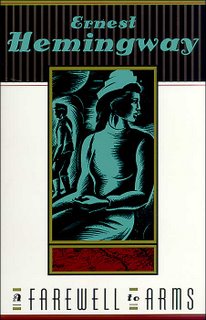 Hemingway, at a nubile 30, composed this taut, gripping tale about an ambulance driver who falls in love with a nurse in the midst of World War 1 in powerful prose. The thing to love most about Hemingway is the way he tells his stories. Unpretentious to the last, you can read his novels at face value or in between the lines (of course, between the lines is always a far richer experience, and Hemingway is a master of the unsaid), and this book is no different. The novel floats back and forth between a never-ending world war filled with desperation and loads of men who don't want to fight in it and a love story that blossoms in a hospital and blooms across the whole of Europe (including a beautifully rendered Switzerland). It is ultimately a beautiful story about love and loss and death and the inexplicable mystery of war and humans killing each other whether they're on the same side or not (at least sometimes). Hemingway is a master, of course, but his books, and this one is no exception, should be read as any other book. They all have their faults, minimal faults, but faults nevertheless. The important thing is that those faults don't govern the story. Here, of course, they do not, and even though the dialogue is often stiff and forced, the romaticism rings true, the war is depressing, and the story itself is uplifting, tragic, human, and evocative beyond many even half-efforts. It's a book that almost demands a second reading. Knowing the end, everything before that takes on more weight, is given more gusto, and rings with a fair necessity that this, friends, is life.
Hemingway, at a nubile 30, composed this taut, gripping tale about an ambulance driver who falls in love with a nurse in the midst of World War 1 in powerful prose. The thing to love most about Hemingway is the way he tells his stories. Unpretentious to the last, you can read his novels at face value or in between the lines (of course, between the lines is always a far richer experience, and Hemingway is a master of the unsaid), and this book is no different. The novel floats back and forth between a never-ending world war filled with desperation and loads of men who don't want to fight in it and a love story that blossoms in a hospital and blooms across the whole of Europe (including a beautifully rendered Switzerland). It is ultimately a beautiful story about love and loss and death and the inexplicable mystery of war and humans killing each other whether they're on the same side or not (at least sometimes). Hemingway is a master, of course, but his books, and this one is no exception, should be read as any other book. They all have their faults, minimal faults, but faults nevertheless. The important thing is that those faults don't govern the story. Here, of course, they do not, and even though the dialogue is often stiff and forced, the romaticism rings true, the war is depressing, and the story itself is uplifting, tragic, human, and evocative beyond many even half-efforts. It's a book that almost demands a second reading. Knowing the end, everything before that takes on more weight, is given more gusto, and rings with a fair necessity that this, friends, is life.There are several covers, as there are several editions. And, given this particular cover, I'm glad I didn't judge the book solely by the cover. It, sadly, blows.
The story behind the novel, and others, can be found here.


No comments:
Post a Comment